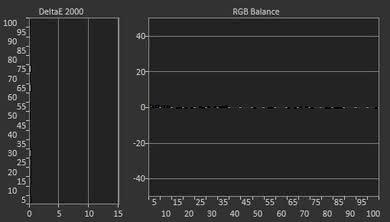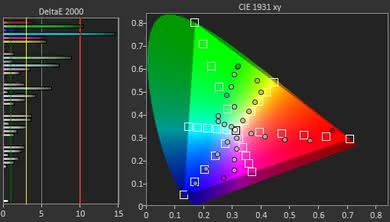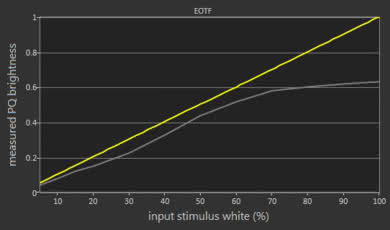Our Verdict
This is a good TV for mixed usage. Its low input lag, good gray and black uniformity along with the fast response time and the handling of popular inputs, make this TV good for most usages. It will, however, please more those who value low input lag and quick response time.
- Can produce deep and uniform dark scenes
- Feels very responsive
- Bad viewing angles
- HDR performance is mediocre
The TV is just okay for SDR movie watching. It has very good contrast, but it lacks local dimming and 24p judder removal. Motion interpolation of the Samsung UN55NU7300 is decent, but out-of-the-box colors lack accuracy. There are TVs that will provide a better movie watching experience.
The Samsung NU7300 is a good TV for watching TV shows. Although reflection handling is not its strong point, the TV can get bright enough to display well SDR content in brighter environments. It will scale-up well cable and Blu-ray content
The Samsung NU7300 is a decent TV for sports watching. Although the response time and the brightness are good and the gray uniformity will not be an issue, the handling of reflections along with the poor viewing angles make the TV not an optimal choice for sports viewing.
This a great TV for gamers. It has very low input lag and a good response time that suits games with fast action. The TV can flicker the backlight to produce a crisper image without creating stutter. The TV can display several input signal resolutions and definitely the most popular ones.
The NU7300 is a decent TV for HDR Movie watching. Although its contrast will produce deep blacks and the black uniformity is good, dark scenes will look dim. This is due to the limited color gamut and limited color volume that stop the TV of producing rich colors.
The Samsung NU7300 is a good TV for HDR gaming as it can handle the demanding input signal, and has a good response time for fast action. In dark scenes though, the colors will look a bit dim and although the blacks will be deep some people will say that the image does not come to life.
This is a good TV for a PC monitor. It has low input lag and good response time, but the viewing angles are limited, and reflection handling is just ok. It is great, however, at handling most input signals you throw at it, and although the slight curvature is a plus, most people will not notice.
Changelog
- Updated May 21, 2020: Converted to Test Bench 1.5.
- Updated Feb 21, 2020: Converted to Test Bench 1.4.
- Updated Feb 28, 2019: Converted to Test Bench 1.3.
- Updated Jun 15, 2018: Review published.
Check Price
Differences Between Sizes And Variants
We tested the 55" (UN55NU7300) version FA01. For the most part, we expect our review to be valid for the 49" (UN49NU7300) and the 65" (UN65NU7300) as well.
If someone comes across a different type of panel or if their Samsung NU7300 doesn't correspond to our review, let us know and we will update the review.
| Size | Model | US | UK |
| 49" | UE49NU7300 | N/A | UE49NU7300KXXU |
| 55" | UN55NU7300 | UN55NU7300FXZA | UE55NU7300KXXU |
| 65" | UN65NU7300 | UN65NU7300FXZA | UE65NU7300KXXU |
Popular TV Comparisons

The Samsung NU7300 is a decent 4k TV without much curved competition, but if you're willing to give up the curve then one of these competing models may be a better choice. See our recommendations for the best smart TVs.
The Samsung NU7300 is marginally better than the Samsung NU7100. The NU7300 is a touch brighter and has a slightly faster response time but this may be just due to small variances between panels. Overall, there is no major difference between the two, though. The NU7100 is available in a wider variety of sizes.
The Samsung NU7300 is a bit better than the Samsung MU7000. The NU7300 has better black uniformity, which is important when viewing in a dark room. It also has less input lag, although both have excellent performance.
The two TVs have different panel types, each with its advantages and disadvantages. If you've got a room with a wide seating arrangement and you'll be watching from the side, then the LG UK6300 is a better choice due to the better viewing angles. If you'll be sitting directly in front, then the Samsung NU7300, is a better choice, as it can get brighter and can also deliver much deeper blacks to improve dark room performance. The LG UK6300 has better reflection handling, which is good if your room has many lights.
The Samsung NU7300 is marginally better than the Samsung MU6300. While there are no major differences between them, the NU7300 has a better backlight with less noticeable flicker.

We buy and test dozens of TVs yearly, taking an objective, data-driven approach to deliver results you can trust. Our testing process is complex, with hundreds of individual tests that take over a week to complete. Most of our tests are done with specially designed test patterns that mimic real content, but we also use the same sources you have at home to ensure our results match the real-world experience. We use two main tools for our testing: a Colorimetry Research CR-100 colorimeter and a CR-250 spectroradiometer.
Test Results
The back of the TV is plastic and has the distinct groves for guiding the cables. In this model, the cables cannot be hidden through the stand as in more premium models, as only a clip is provided to guide them along the legs.
The Samsung NU7300 has an excellent contrast ratio. It has no problem displaying deep blacks in a dark room. This is in the same ballpark as other Samsung TVs with VA panels, like the flat NU7100.
The Samsung UN55NU7300 has no local dimming option. The video is provided for reference only.
Good SDR peak brightness. In dark scenes with a small bright highlight, the TV reduces the overall brightness to produce deeper dark scenes and thus highlights don't look too bright. Brightness, however, does remain consistent in less dark scenes, and the TV is ok for most rooms. It is just slightly brighter than its flat counterpart the NU7100
The HDR peak brightness of the TV is mediocre. It is just slightly brighter than the flat NU7100 but this may be due to unit variance. Is far behind the brightness levels of the TCL R617. The TV does keep similar brightness levels regardless of the window sizes, but dark scene highlights are not boosted at all.
The Samsung NU7300 has good gray uniformity. On the 50% gray image, although there are uniformity issues, this is mostly darkening of the edges which doesn't create much dirty screen effect. These uniformity issues are not likely to cause dark spots on the screen, and this should make sports fans happy as no clouding will be visible in panning shots.
Similar and even better results are obtained at the 5% gray and this great.
The viewing angle is poor. Blacks fade as soon as you move from the center, colors start shifting at slightly larger angles. Finally, brightness is the last image quality that deteriorates as viewing angle increases.
This TV is not suitable for a wide viewing environment.
The out-of-the-box color accuracy is decent. We obtained the best results with the Movie Picture mode.
The white dE and the color dE are a bit off, but these differences are too small to bother most people. Gamma is higher than our target and thus some dark details is lost. The colors are a little warm and this explains the faint red and yellow image tint.
Update 04/12/2019: This TV was incorrectly measured with Brightness +2, instead of at 0. This only has a small impact on the results (slightly dimmer dark scenes below about 30 IRE) and so we don't plan to retest it.
The post calibration color accuracy is remarkable. We were able to significantly lower the white balance dE, the Gamma was right on the 2.2 target and color temperature was almost perfect.
As with most 2018 Samsung TVs, we were unable to completely fix the color dE, although it was brought down to levels where very few people might notice.
You can see our recommended settings here.
The color gamut is okay. The TV is only capable of covering about 3/4 of the DCI P3 space and only just a little more than half of the Rec. 2020 space.
The EOTF in Movie mode undershoots the target PQ curve significantly, so HDR content looks a little dimmer than normal. This is made less severe by setting Contrast Enhancer to Low, as shown in this plot.
The Game Mode EOTF photo shows that the same undershooting happens in this mode too. In the PC Mode EOTF, there is still some undershooting of the PQ curve, but it starts at higher input signal luminosity.
The Samsung NU7300 has a disappointing color volume as it fails to cover the color space in various luminosity levels. Colors look dim in darker scenes and the TV fails to display the creator intended content accurately. This is also due to the limited color gamut.
The gradient on the Samsung UN55NU7300 is good. Although there is small banding pretty much everywhere, no major banding can be observed in any color except in dark green
Setting Digital Clean View to 'auto' smooths the gradient but can't fix it and causes a lost of fine details.
The VA panel in our long-term test appears to be immune so we do expect not this TV to experience permanent image retention.
The response time of the Samsung NU7300 is good. The pixels transition fast and should please sports viewers and gamers. At the same time, there is some blur in the image which is mainly caused by the backlight flickering. The response time is a bit faster than that of the flat NU7100, but this may come down to unit variance and these small response time differences are also visible in the moving logo photo.
Just like the NU7100, the NU7300 uses PWM at 240Hz to dim the backlight except when at 100%.
However, when the motion interpolation is enabled through the Auto Motion Plus option the flicker frequency of the backlight changes to 120Hz as shown in this plot.
This causes worse duplications in the motion as shown in this photo
The BFI is great.
In Game mode, 60Hz flicker is not possible, but the backlight flicker stays at 120Hz in Game mode as shown in this plot.
Motion Interpolations is decent. Some occasional artifacts can be seen, and the TV stops interpolating when there's too much motion.
Note: that when Auto Motion Plus is enabled the backlight flicker changes to 120Hz, as shown in this plot.
The Samsung NU7300 has a very good stutter results as there is practically no stutter on the 60fps signal, but there might be a slight stutter on 24p content. This, however, will not be noticeable by most people.
Just like the NU7100, the NU7300 cannot remove judder from 24fps content. This holds true no matter if the content is 60p/i or from native 24fps content played from a Blu-ray.
This isn't a big issue since most people are not very sensitive to judder and probably won't notice it.
This TV does not support VRR
Excellent low input lag, better than last year's MU6300. When the input is set to PC, the input lag is automatically the lowest possible.
There is no improvement in input lag if you activate Game mode within PC mode. The NU7300 does not a have a Game Motion Plus like the higher end Samsungs.
The Samsung NU7300 is decent at resolution support. The following settings have to be implemented:
- The resolution 4k@60Hz @ 4:4:4 or @ 4:2:2 is only supported when HDMI UHD Color is enabled
- 4:4:4 Chroma is only properly displayed when the input icon is set to PC (aka PC mode)
- In PC mode, Sharpness is set to '10' by default and this means no added sharpness. However, you can 'soften' the image if you decide to reduce it.
The TV includes inputs for a composite or component connection. As the connection is shared it is not possible to connect a component and composite connection at the same time.
The TV can passthrough Dolby Digital signal, but no DTS.
Anynet+ (HDMI-CEC) is needed for ARC, which passes on HDMI 3 only.
The Samsung NU7300 has an average frequency response. LFE (low-frequency response) is at 80Hz, which is decent. This results in a sound that doesn't lacks thump and rumble, but have some punch to its bass. The response above the LFE point is decently balanced, which is important for producing clear and intelligible dialogs. However, this TV doesn't get very loud and produces some compression and pumping artifacts under max volume. It doesn't have a room correction system either, which is why it wasn't to remove the modes of our test room around 200Hz.
The distortion performance is decent. The overall amount of harmonic distortion is within acceptable limits and doesn't increase dramatically at max volume either. However, this TV doesn't get very loud.
The interface is characterized as good mainly due to the speed of menu loading. It feels choppy interface with minimal animations but is faster than the NU8500
Unfortunately, the NU7300 comes with ads and suggested content, and does not offer the option to opt out.
The remote is ok, but it is worth noting that this TV has no voice control. The buttons cover most of the basic functions, including inputs, quick access to the settings menu, and a picture size button to control the upscaling options for lower resolution content.
There is a single button located underneath the TV, similar to the NU7100. Pressing the button brings up a menu that can power cycle the TV, control volume, channels, and change inputs.













































